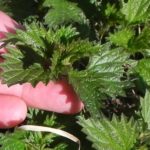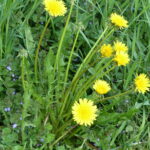Our Yards Offer Nutrition
Every spring we look forward to eating delicious, free, wild greens that grow in our yard and just about every place people live. Having an ability to identify, pick, prepare, and eat wild foods gives us some comfort in this age of uncertainty.
We encourage everyone to boost their backyard food production through gardening, backyard chickens for those who can keep them, and foraging. Here are a few things to consider before picking and eating any wild plant.
- Make sure you’ve identified the plant correctly. Use two sources to confirm identification. These might be an expert forager and a book or Internet source or a combination.
- Make sure the plants have not been contaminated by pesticides, animal feces, or vehicle exhaust. It’s best to forage away from busy roads. Wash plants thoroughly before preparing.
- Eat just a small portion the first time. Although it might be fine food for most people there’s a chance you might be allergic to it.
Nettles

Carefully pluck the top three leaves off.
The key to enjoying all wild greens is to harvest them when they are very young. Many edible wild plants are tender and delicious shortly after they sprout but soon get coarse and bitter as warm weather stimulates their growth.
Nettles, sometimes called stinging nettles, live in moist places near streams, ponds, and woods, where they seem to prefer light shade. We have a couple of patches in our yard. They green up early in the spring, and we pick them before they are ten inches tall. We carefully pick just the top three or four small leaves. Remember these are stinging nettles. Wear light gloves or carefully pinch the top growth off the plant between the thumb and index finger. About a hundred leaf clusters make a great dish for the two of us. Rinse the nettles and boil them for a few minutes. The stinging part is a protein that dissolves in boiling water. We put a dab of butter on the drained cooked nettles and drink the water as a delicious spring tea.
Dandelions

By mid-summer dandelion leaves are tough and bitter.
Because of herbicide companies’ promotions, just about everyone dislikes dandelions. Some have heard that dandelions are edible. It is true and, we need to thank our European ancestors for bringing dandelions to the New World. Otherwise, they might not have survived. They are high in vitamin A, folate, vitamin K, and vitamin C and a good source of calcium and potassium. Today, folks from Mediterranean countries grow and harvest dandelions as crops. They are a popular dish in Italian communities.
The few people who have tried eating them make the mistake of picking mature leaves in mid-summer. By that time, they are bitter and inedible. The best dandelion leaves are those picked in early spring and have been under a blanket of leaves. They’ll be partially blanched and delicious. It’s fine to pick small young leaves that can be added to salads if they are not too bitter. If they are bitter, boil two pots of water. Put the leaves in one pot and boil for a couple of minutes. Drain and put them in the second pot of boiling water and boil for another minute or so. The boiling removes the bitterness. Drain and enjoy with butter and salt and pepper.
This is a year of great anxiety and having some knowledge of how to find free food nearby can remove some of that concern.


Just ate our second dandelion salad of the stay at home season. Washed well, picked through and combined with fresh orange pieces, walnuts and snipped chives. The juice out of an orange half can be the “vinegar” in a sunflower dressing. Salt and pepper and it’s delicious! Plan to harvest this weed throughout spring.
Wow! This sounds amazing, Sigrid!
When a child living in New Boston, NH, my mom taught us how to not only pick the best dandelion leaves, but also milkweed. Back in the forties and fifties these natural foods served our meals well. Then we would move on to the great vegetables growing in my dad’s huge vegetable garden.
Send along a short blog about this. I remember plucking the tips of the milkweed off, boiling them a few times and eating with salt, pepper, butter. These days, I would leave the milkweed for the butterflies.